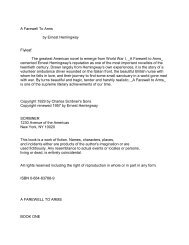- Page 2 and 3: English GrammarENGLISH GRAMMAR: EXP
- Page 4 and 5: a. Questionsb. Negative statementsc
- Page 8 and 9: d. Nouns followed by descriptive ph
- Page 10 and 11: iii. The comparative form followed
- Page 12 and 13: 2. Phrasal verbs consisting of a ve
- Page 14 and 15: Simple PastPast ContinuousPast Perf
- Page 16 and 17: we have been showingthey have been
- Page 18 and 19: Present ContinuousI am beingyou are
- Page 20 and 21: Future Perfect ContinuousI will (sh
- Page 22 and 23: egi n began begunbend bent bentbind
- Page 24 and 25: spend spent spentspin span or spun
- Page 26 and 27: For instance, the Simple Present ca
- Page 28 and 29: verb are.In spoken English, the fol
- Page 30 and 31: 4. Change the affirmative statement
- Page 32 and 33: Infinitiveto beto walkto workBare I
- Page 34 and 35: pronounced as a separate syllable i
- Page 36 and 37: Without contractionsDo I not work?D
- Page 39 and 40: 6. Change the following affirmative
- Page 41 and 42: 1. Uses of the present continuousIn
- Page 43 and 44: short; whereas the underlined vowel
- Page 45 and 46: Infinitiveto ggnalto travelto comto
- Page 47 and 48: 1. Using the Present Continuous ten
- Page 49 and 50: 19. infer: They are ______ that we
- Page 51 and 52: 1. Am I learning English? 2. Are yo
- Page 53 and 54: a. Verbs ending in a silent eWhen a
- Page 55 and 56: misswatchmissedwatchedHowever, when
- Page 57 and 58:
We have worked.They have worked .We
- Page 59 and 60:
They have been working.They have no
- Page 61 and 62:
3. It ________. (to stop)4. We ____
- Page 63 and 64:
1 ________ all night. (to work)I ha
- Page 65 and 66:
In addition, the Simple Past is use
- Page 67 and 68:
lettakelettooklettakenLike the regu
- Page 69 and 70:
See Exercise 7.3. The simple past o
- Page 71 and 72:
5. They ______ to catch the bus. (t
- Page 73 and 74:
3. Was he an artist? He was not an
- Page 75 and 76:
example, the use of the Past Contin
- Page 77 and 78:
As is the case with other English t
- Page 79 and 80:
Tag questions are formed using the
- Page 81 and 82:
I was ready.It was ready.They were
- Page 83 and 84:
4. Using the Past Perfect tense, fi
- Page 85 and 86:
__ he_____ well? (to feel)Had he be
- Page 87 and 88:
was living 7. Were, eating 8. was f
- Page 89 and 90:
Thus, in formal English, the Simple
- Page 91 and 92:
In this conjugation, the expression
- Page 93 and 94:
It will be working.They will be wor
- Page 95 and 96:
You will have been traveling a grea
- Page 97 and 98:
conjunction. In the following examp
- Page 99 and 100:
9. 1 ________ here. (to remain)10.
- Page 101 and 102:
1. You __________ with us. (to come
- Page 103 and 104:
8.____he_________the puzzle? (to so
- Page 105 and 106:
windows? Won't you wash the windows
- Page 107 and 108:
2. Formation of conjugations with t
- Page 109 and 110:
Affirmative Statement:Question:Nega
- Page 111 and 112:
Perfect continuous conjugation with
- Page 113 and 114:
following day; and next year must b
- Page 115 and 116:
___ theynot __ their car? (to drive
- Page 117 and 118:
7. She would have known what to do.
- Page 119 and 120:
Answers to Exercise 1 :1. Would she
- Page 121 and 122:
e.g. If I were rich, I would travel
- Page 123 and 124:
she has workedit has workedwe have
- Page 125 and 126:
As illustrated in these examples, t
- Page 127 and 128:
SameLaterSimple Past Subj unctive o
- Page 129 and 130:
past time, the Perfect conjugation
- Page 131 and 132:
iii. SummaryThe forms of the Subjun
- Page 133 and 134:
Answers2. Complete each of the foll
- Page 135 and 136:
Were I in yo ur position. I would p
- Page 137 and 138:
If he did not like his work, he wou
- Page 139 and 140:
1. Don"t _____ out late. (to stay)2
- Page 141 and 142:
SimpleI could workyou could workhe
- Page 143 and 144:
Affi rmative StatementShe can work.
- Page 145 and 146:
e.g. You must not leave.He must not
- Page 147 and 148:
musthave toIt should be noted that
- Page 149 and 150:
The following are examples of quest
- Page 151 and 152:
We could have found it.Could we hav
- Page 153 and 154:
I wish I could speak Portuguese.The
- Page 155 and 156:
what we want.8. You _____ be please
- Page 157 and 158:
8. Had he been wanting to travel?An
- Page 159 and 160:
Answers to Exercise 5:1. He thinks
- Page 161 and 162:
Many English verbs can be used eith
- Page 163 and 164:
e.g. We gave the child a toy.I sent
- Page 165 and 166:
Yesterday, he 1!Y. in bed until ten
- Page 167 and 168:
5. They _______ four children. (to
- Page 169 and 170:
In these examples, the verbs was st
- Page 171 and 172:
he will beshe will beit will bewe w
- Page 173 and 174:
contracted form of not follows imme
- Page 175 and 176:
e.g. Active: The boys are mowing th
- Page 177 and 178:
she have been shownit have been sho
- Page 179 and 180:
1. They were recognized immediately
- Page 181 and 182:
9. The stranger could have bought t
- Page 183 and 184:
4. Past Perfect: I had transferred
- Page 185 and 186:
matchbuspassdishmarshaxfoxbuzzmatch
- Page 187 and 188:
staffwharfstaffs or staveswharfs or
- Page 189 and 190:
% %'si. Irregular pluralsThe Englis
- Page 191 and 192:
The day seemed long.The days seemed
- Page 193 and 194:
The thesis will have been reviewed
- Page 195 and 196:
omitted.Answers to Exercise 8:1. Th
- Page 197 and 198:
In many languages, the word for a i
- Page 199 and 200:
The eagle is a bird of prey.In the
- Page 201 and 202:
10. At __ equator, sunrise occurs a
- Page 203 and 204:
The is used with plural countable n
- Page 205 and 206:
the Atlantic Oceanthe st. Lawrence
- Page 207 and 208:
Frogs are amphibians.A frog is an a
- Page 209 and 210:
4. Suez Canal connects Mediterranea
- Page 211 and 212:
d) names of languages:e.g. EnglishG
- Page 213 and 214:
wheatmilksunlighta grai n of wheata
- Page 215 and 216:
e.g. They are watching television.W
- Page 217 and 218:
c. Verbs followed by gerundsOther E
- Page 219 and 220:
One bag of flour is on the counter.
- Page 221 and 222:
1. Ways in which possession is indi
- Page 223 and 224:
A collective noun takes a singular
- Page 225 and 226:
Plural noun nearest the verb or/nor
- Page 227 and 228:
2. The crew ___ different levels of
- Page 229 and 230:
has [considered as a whole]Answers
- Page 231 and 232:
. Singular and plural antecedentsEn
- Page 233 and 234:
It is Friday.The pronoun it can als
- Page 235 and 236:
objects of prepositions.e.g. Please
- Page 237 and 238:
itsourtheir[its]ourstheirsExcept fo
- Page 239 and 240:
Answers2. Paying attention to the m
- Page 241 and 242:
6. He is our neighbor. We have know
- Page 243 and 244:
We went to the post office, but the
- Page 245 and 246:
Their swooping and darting was a si
- Page 247 and 248:
ANSWERS TO THE EXERCISES for Chapte
- Page 249 and 250:
the objective case as in the subjec
- Page 251 and 252:
and can be referred to as demonstra
- Page 253 and 254:
It should be noted that when who is
- Page 255 and 256:
In the first example, Who is there?
- Page 257 and 258:
It should be noted that in sentence
- Page 259 and 260:
the commas indicate that the clause
- Page 261 and 262:
See Exercises 14 and 15.In informal
- Page 263 and 264:
Is __jacket too large?Is this jacke
- Page 265 and 266:
6. Paying attention to correct word
- Page 267 and 268:
Answers9. For each of the following
- Page 269 and 270:
11. Which students are ready? (Will
- Page 271 and 272:
6. You should never be afraid to st
- Page 273 and 274:
As indicated below, many determiner
- Page 275 and 276:
UNwhat grasstrees to be specifiedas
- Page 277 and 278:
of particular grasssuch plural eN s
- Page 279 and 280:
In informal English, plural possess
- Page 281 and 282:
The words some, somebody, someone,
- Page 283 and 284:
e.g. Please pass me the other cup.I
- Page 285 and 286:
I saw him several times.Meaning: I
- Page 287 and 288:
There are two trees on the lawn. __
- Page 289 and 290:
I do not need to buy any shoes.1. I
- Page 291 and 292:
1. __ My friend drew the one existi
- Page 293 and 294:
CHAPTER 21. ADJECTIVES: POSITION IN
- Page 295 and 296:
certain other determiners such as a
- Page 297 and 298:
As indicated in the preceding table
- Page 299 and 300:
yellow brown scarletgreen beige cri
- Page 301 and 302:
See Exercise 7.Defining adjectives
- Page 303 and 304:
object being described.For example,
- Page 305 and 306:
pronouns can be used with predicate
- Page 307 and 308:
Robin Harris was late.the late Robi
- Page 309 and 310:
e.g. The table near the door is mad
- Page 311 and 312:
nouns to be modified.See Exercise 1
- Page 313 and 314:
1. maps (our, ten)2. cows (twenty·
- Page 315 and 316:
a plastic cupa green carton used f
- Page 317 and 318:
sentences, changing the attributive
- Page 319 and 320:
The ___ treasure was discovered acc
- Page 321 and 322:
AnswersANSWERS TO THE EXERCISES for
- Page 323 and 324:
Answers to Exercise 16:1. surprisin
- Page 325 and 326:
See Exercise 2.a. The positive form
- Page 327 and 328:
The adjectives which use endings in
- Page 329 and 330:
As shown above, the adjective far h
- Page 331 and 332:
vii. Progressive comparisonsAs well
- Page 333 and 334:
It should be noted that this use of
- Page 335 and 336:
Angela and TomAngela is twice as ol
- Page 337 and 338:
6. Complete the followi ng sentence
- Page 339 and 340:
10. Rewrite each of the following s
- Page 341 and 342:
Ted is the tallest child in the gro
- Page 343 and 344:
1. Ray is the heaviest child in the
- Page 345 and 346:
Tom became more and more anxious.Th
- Page 347 and 348:
intelligentinterestingmore intellig
- Page 349 and 350:
adjective much is rarely used in ei
- Page 351 and 352:
The comparative forms more, fewer a
- Page 353 and 354:
end of a sentence. This type of con
- Page 355 and 356:
2. That is a complex question. (you
- Page 357 and 358:
There was ___ furniture in the room
- Page 359 and 360:
1. We had many adventures.2. Few vi
- Page 361 and 362:
more expensive bicycles than we do.
- Page 363 and 364:
e.g. The train travels very quickly
- Page 365 and 366:
In the first example, seldom follow
- Page 367 and 368:
adverb of time.e.g. I sometimes see
- Page 369 and 370:
Connecting adverb phrases are most
- Page 371 and 372:
It can be seen that the order of th
- Page 373 and 374:
g. Negative adverbsNegative adverbs
- Page 375 and 376:
In the following examples, the subo
- Page 377 and 378:
Answers4. The following sentences d
- Page 379 and 380:
Write two corrected versions for ea
- Page 381 and 382:
school. 8. Birds often return to th
- Page 383 and 384:
surprisingsurprisinglyi. Adjectives
- Page 385 and 386:
It should be noted that in addition
- Page 387 and 388:
Adjective: She is a good musician.A
- Page 389 and 390:
i. Adverbs used with More and MostM
- Page 391 and 392:
As is the case with comparisons usi
- Page 393 and 394:
ii. The construction with The Least
- Page 395 and 396:
2. He is a _______ businessman. (su
- Page 397 and 398:
Finally, the rain drummed decreasin
- Page 399 and 400:
Answers to Exercise 6:1. The train
- Page 401 and 402:
2. On the other side of: There is a
- Page 403 and 404:
During1. Throughout a period: She w
- Page 405 and 406:
1. For each: 60 kilometers per hour
- Page 407 and 408:
not at all: not in any wayat all ti
- Page 409 and 410:
in any case: whatever happensin bri
- Page 411 and 412:
ule of thumb: a simple way to calcu
- Page 413 and 414:
keep something to oneself: not tell
- Page 415 and 416:
a response toshut one's eyes to (de
- Page 417 and 418:
Toacceptable toaccustomed toaddicte
- Page 419 and 420:
ecoil fromrefrain fromstem fromInbe
- Page 421 and 422:
We have been traveling __ several d
- Page 423 and 424:
Do you have any objection to my pla
- Page 425 and 426:
1. at 2. for 3. between 4. in 5. fo
- Page 427 and 428:
uild on: develop fromburst into: su
- Page 429 and 430:
underlined.e.g. We reasoned patient
- Page 431 and 432:
die down: become lessdouble up: ben
- Page 433 and 434:
are forgottenlook up: find (informa
- Page 435 and 436:
smooth over: improveWe tried to smo
- Page 437 and 438:
Pronoun object is placedafter the p
- Page 439 and 440:
un acrossstumble acrossVerb + Prepo
- Page 441 and 442:
Intransitive Verbs followed by word
- Page 443 and 444:
fit in with: be suited tofool aroun
- Page 445 and 446:
8. He will take care of everything.
- Page 447 and 448:
Answers7. For each of the following
- Page 449 and 450:
5. They had to turn away twenty peo
- Page 451 and 452:
what: They sent it in. 5. where: Ch
- Page 453 and 454:
The most commonly used correlative
- Page 455 and 456:
Whether1. if: I do not know whether
- Page 457 and 458:
a. Stress and punctuationIn spoken
- Page 459 and 460:
In the first example, the two phras
- Page 461 and 462:
Do you know ____ the stores are ope
- Page 463 and 464:
2. He walked up to the door ______
- Page 465 and 466:
furthermore 19. however 20. or 21.
- Page 467 and 468:
Adverbs, inverted word order with n
- Page 469 and 470:
oth, used as determinerbut, used as
- Page 471 and 472:
ed endingeither ... oreither, used
- Page 473 and 474:
himhimselfhishis or herhow, use ofh
- Page 475 and 476:
lots ofly added to adjectives endin
- Page 477 and 478:
Numbers and letters, formation of p
- Page 479 and 480:
Plural countable nouns, used in nam
- Page 481 and 482:
ise, verb formsround, used as prepo
- Page 483 and 484:
Tenses, summary of the uses ofthan,
- Page 485 and 486:
Verb + adverb, examples of transiti
- Page 487:
without, use ofwithout, used in idi













